Distinguishing Capillary Fringe Reflection in a GPR Profile for Precise Water Table Depth Estimation in a Boreal Podzolic Soil Field
Abstract
1. Introduction
2. Materials and Methods
2.1. GPR Theory
2.2. Study Area
2.3. Data Collection and Basic Proccessing
- PulseEKKO® Pro GPR system (Sensors and Software Inc., Mississauga, ON, Canada) with 100 and 250 MHz center frequency antennas
- Em50 data logger, and water level, electrical conductivity-, temperature- and SM-probes (METER group Inc. (former Decagon Devices), Pullman, DC, USA)
- EKKO Project V3 R1 and IcePicker V3 R7 GPR data processing Software (Sensors and Software Inc., Mississauga, ON, Canada)
- Edit the first break (time-zero correction)
- Apply dewow and SEC2 (Spreading and Exponential Compensation) gain
- Background subtraction—applied to the full length of the trace
2.4. Data Analysis
3. Results and Discussion
3.1. GPR Survey Outputs
3.2. Estimation of DCF
3.3. Site-Specific Relationship for WTDm vs. DCF
3.4. Evaluation of Results
3.4.1. Calculation of εr
3.4.2. Correlation Analysis
4. Summary
Author Contributions
Funding
Acknowledgments
Conflicts of Interest
Abbreviations
| BH | Borehole |
| CMP | Common mid-point |
| CO | Common offset |
| DCF | Depth to the top of the capillary fringe |
| GPR | Ground Penetrating Radar |
| max | Maximum |
| min | Minimum |
| n | Number of samples |
| NL | Newfoundland |
| PBRS | Pynn’s Brook Research Station |
| r | Correlation coefficient |
| Rx | Receiver antenna |
| SM | Soil moisture |
| TDR | Time Domain Reflectometry |
| trw | Reflected wave travel time |
| TWTT | Two-way travel time of GPR waves |
| Tx | Transmitter antenna |
| v | Average radar velocity |
| vrw | Reflected wave velocity |
| WTD | Water table depth |
| WTDm | Measured water table depth |
| WTDp | Predicted water table depth |
| α | Attenuation coefficient/ significance interval |
| ε | Absolute permittivity |
| ε0 | Permittivity of a vacuum |
| εr | Relative permittivity (dielectric constant) |
| θv | Volumetric soil moisture content |
| σ | Electrical conductivity |
Appendix A. Graphs of Measured Data
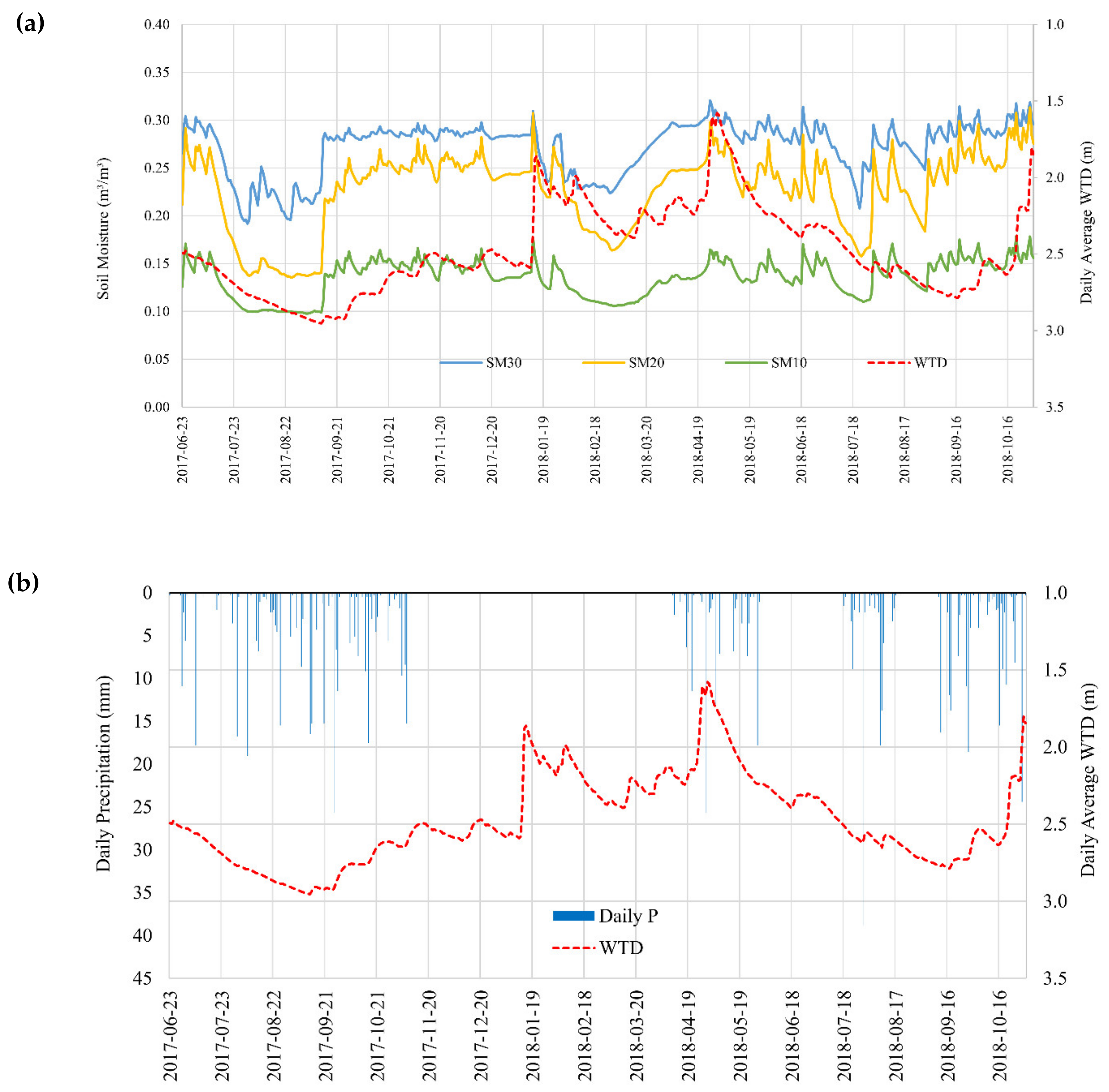

Appendix B. Summary of Statistical Analysis
Comparing the Slopes of Regression Line and Prediction Line with 1:1 Line
| Regression | 1:1 Line | sb1-b2 | 0.085 | |
|---|---|---|---|---|
| n | 16 | 16 | t | 0.146 |
| b | 1.012 | 1.000 | df | 28 |
| sy.x | 0.086 | 0.000 | α | 0.050 |
| sx | 0.264 | 0.264 | p-value | 0.885 |
| sb | 0.085 | 0.000 | t-critical | 2.048 |
| significant | No |
| Regression | 1:1 Line | sb1-b2 | 0.169 | |
|---|---|---|---|---|
| n | 8 | 8 | t | 3.536 |
| b | 1.597 | 1.000 | df | 12 |
| sy.x | 0.086 | 0.000 | α | 0.050 |
| sx | 0.171 | 0.171 | p-value | 0.004 |
| sb | 0.169 | 0.000 | t-critical | 2.179 |
| significant | Yes |
Appendix C. Tables & Figures
| Date | WTD | GW-Temp (°C) | GW-EC (mS/cm) | SM30 (m3/m3) | SM20 (m3/m3) | Temp 20 (°C) | SM10 (m3/m3) | Daily P (mm) | Daily E (mm) | |||
|---|---|---|---|---|---|---|---|---|---|---|---|---|
| 28 July 2017 | 2.74 | 7.4 | 0.278 | 0.1972 | 0.1449 | 21.0 | 0.1029 | 0.3 | 2.3 | |||
| 18 August 2017 | 2.85 | 8.4 | 0.281 | 0.2153 | 0.1424 | 17.5 | 0.0996 | 0.8 | 3.1 | |||
| 29 August 2017 | 2.89 | 8.8 | 0.280 | 0.2294 | 0.1394 | 16.5 | 0.0993 | 0.0 | 3.7 | |||
| 15 September 2017 | 2.91 | 9.2 | 0.290 | 0.2822 | 0.2162 | 14.0 | 0.1384 | 0.0 | 3.1 | |||
| 03 October 2017 | 2.77 | 9.4 | 0.287 | 0.2808 | 0.2344 | 9.4 | 0.1407 | 0.0 | 2.3 | |||
| 07 November 2017 | 2.63 | 9.2 | 0.301 | 0.2966 | 0.2803 | 8.0 | 0.1662 | 15.2 | 0.4 | |||
| 01 June 2018 | 2.24 | 4.7 | 0.270 | 0.2890 | 0.2469 | 11.8 | 0.1501 | 0.0 | 3.9 | |||
| 20 July 2018 | 2.54 | 6.4 | 0.259 | 0.2260 | 0.1668 | 20.8 | 0.1138 | 0.0 | 5.7 | |||
| 09 August 2018 | 2.65 | 8.8 | 0.252 | 0.2923 | 0.2606 | 20.7 | 0.1627 | 13.7 | 3.6 | |||
| 07 September 2018 | 2.75 | 9.1 | 0.266 | 0.2932 | 0.2605 | 16.1 | 0.1598 | 0.0 | 2.6 | |||
| 03 October 2018 | 2.54 | 9.6 | 0.267 | 0.2850 | 0.2534 | 8.5 | 0.1480 | 0.0 | 1.0 | |||
| 31 October 2018 | 1.85 | 9.3 | 0.264 | 0.2960 | 0.2756 | 6.8 | 0.1560 | 0.3 | 0.0 | |||
| Date | P-E 1 | P-E 2 | P-E 3 | P-E 4 | P-E 5 | P-E 6 | P-E 7 | P-E 8 | P-E 9 | P-E 10 | P-E 11 | P-E 12 |
| 28 July 2017 | −2.1 | −6.8 | −12.0 | −16.3 | −20.5 | −25.5 | −28.9 | −32.0 | −31.6 | −36.0 | −41.5 | −46.6 |
| 18 August 2017 | −2.4 | −4.1 | −5.4 | −10.0 | −13.6 | −8.7 | −5.9 | −10.7 | −15.5 | −19.3 | −22.7 | −6.0 |
| 29 August 2017 | −3.7 | −7.6 | −11.1 | 3.7 | 0.3 | 1.4 | 3.2 | 1.9 | 0.7 | 2.1 | −1.5 | −3.9 |
| 15 September 2017 | −3.1 | −5.8 | 8.1 | 24.2 | 23.1 | 21.0 | 18.4 | 19.8 | 27.0 | 24.9 | 21.6 | 25.1 |
| 03 October 2017 | −2.3 | −4.1 | −6.4 | −7.8 | −8.1 | 2.9 | 8.9 | 33.9 | 32.6 | 31.6 | 31.3 | 29.0 |
| 07 November 2017 | 14.9 | 22.2 | 20.9 | 29.7 | 30.6 | 29.4 | 27.8 | 27.8 | 27.1 | 26.2 | 27.3 | 31.3 |
| 01 June 2018 | −3.9 | −7.8 | −10.1 | 7.1 | 3.4 | 0.8 | −0.5 | −0.8 | 1.2 | 7.3 | 5.5 | 2.8 |
| 20 July 2018 | −5.7 | −9.1 | −10.5 | −14.7 | −14.7 | −14.7 | −14.7 | −14.7 | −14.7 | −14.7 | −14.7 | −14.7 |
| 09 August 2018 | 10.2 | 25.6 | 25.1 | 22.5 | 23.1 | 20.6 | 17.1 | 16.8 | 11.7 | 6.8 | 5.5 | 42.1 |
| 07 September 2018 | −2.6 | −2.6 | −2.6 | −2.6 | −2.6 | −2.6 | −2.6 | −2.6 | −2.6 | −5.2 | −8.3 | −11.7 |
| 03 October 2018 | −1.0 | −2.7 | −3.3 | −5.2 | −2.0 | 15.7 | 25.5 | 24.7 | 22.6 | 20.9 | 21.6 | 27.7 |
| 31 October 2018 | 0.2 | −0.3 | 23.7 | 42.0 | 41.5 | 41.0 | 48.9 | 51.9 | 51.2 | 50.9 | 79.0 | 89.3 |
| Date | P-E 13 | P-E 14 | P-E 15 | P-E 16 | P-E 17 | P-E 18 | P-E 19 | P-E 20 | εr−avg | εr1 | εr2 | εr3 |
| 28 July 2017 | −51.8 | −56.9 | −62.3 | −67.9 | −71.2 | −75.5 | −80.9 | −83.9 | 6.5 | 13 | 7.5 | 6.1 |
| 18 August 2017 | −9.2 | −13.8 | −18.0 | −22.4 | −24.2 | −8.4 | −12.1 | −-15.0 | 6.5 | 11 | 7.8 | 6 |
| 29 August 2017 | −5.6 | −7.0 | −11.5 | −15.1 | −10.2 | −7.4 | −12.3 | −17.1 | 5.3 | 20 | 8.1 | 4 |
| 15 September 2017 | 21.7 | 20.6 | 24.4 | 22.9 | 19.1 | 15.4 | 11.5 | 8.0 | 5.7 | 14 | 11 | 4.2 |
| 03 October 2017 | 26.2 | 40.2 | 41.0 | 38.3 | 36.6 | 40.5 | 37.3 | 34.7 | 7.9 | 6.2 | 12 | 7 |
| 07 November 2017 | 29.9 | 28.4 | 26.8 | 25.5 | 24.7 | 26.5 | 29.9 | 28.5 | 11.2 | 13 | 14 | 11 |
| 01 June 2018 | 5.8 | 2.6 | 0.1 | 0.3 | −0.6 | 2.7 | −0.5 | −3.1 | 13.3 | 15 | 12 | 14 |
| 20 July 2018 | −14.7 | −14.7 | −14.7 | −14.7 | −14.7 | −14.7 | −14.7 | −14.7 | 7 | 20 | 8.6 | 6.3 |
| 09 August 2018 | 38.7 | 38.5 | 34.8 | 33.3 | 34.3 | 42.4 | 41.7 | 36.9 | 5.8 | 6.5 | 13 | 4 |
| 07 September 2018 | −15.0 | −18.6 | −22.6 | −24.4 | −26.8 | −30.6 | −33.9 | −37.9 | 5.4 | 4 | 13 | 4.1 |
| 03 October 2018 | 26.0 | 25.4 | 23.7 | 36.9 | 48.6 | 49.0 | 45.8 | 42.8 | 10.8 | 8 | 12 | 11 |
| 31 October 2018 | 91.0 | 99.6 | 99.6 | 114.3 | 115.3 | 116.7 | 116.8 | 116.9 | 16.5 | 23 | 13 | 17 |
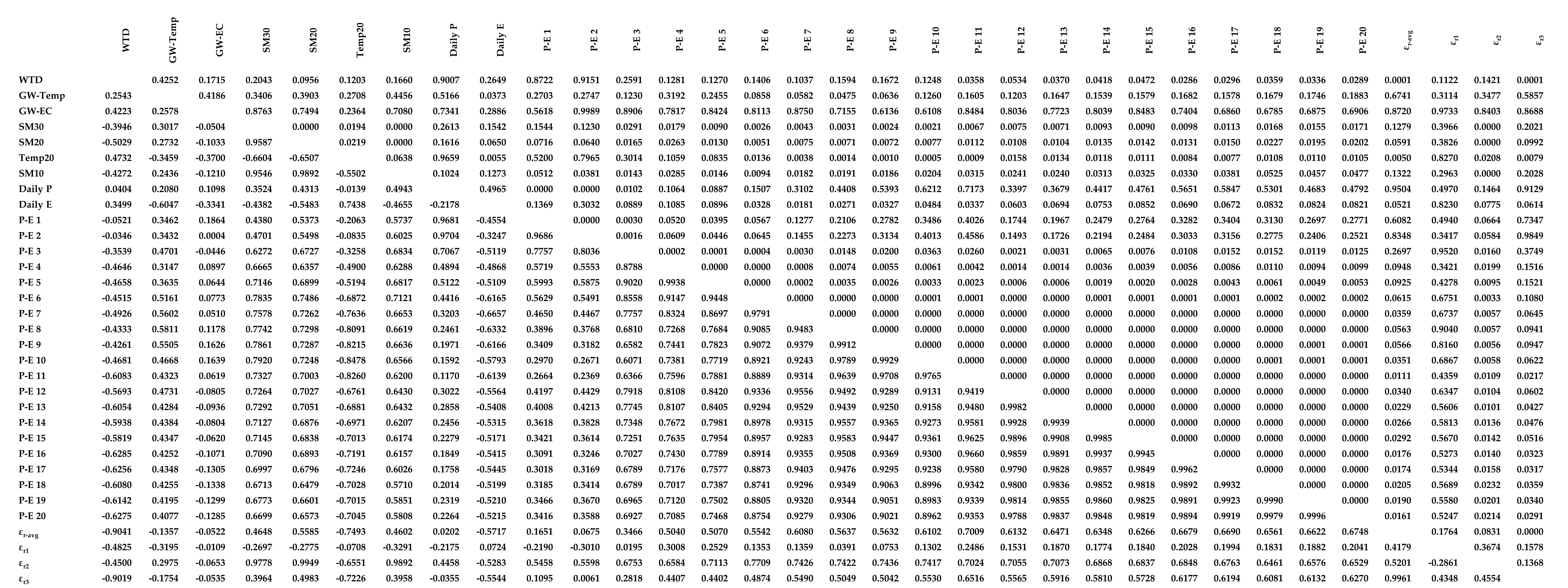
References
- De Marsily, G. Quantitative Hydrology; Elsevier: New York, NY, USA, 1986; p. 440. [Google Scholar]
- Selker, J.S.; Keller, C.K.; McCord, J.T. An introduction to the vadose zone. In Vadose Zone Processes; CRC Press LLC: Boca Raton, FL, USA, 1999; pp. 3–20. [Google Scholar]
- Tindall, J.A.; Kunkel, J.R.; Anderson, D.E. Unsaturated water flow in soil. In Unsaturated Zone Hydrology for Scientists and Engineers, 1st ed.; McConnin, R.A., Ed.; Prentice-Hall, Inc.: Upper Saddle River, NJ, USA, 1999; pp. 183–199. [Google Scholar]
- Doolittle, J.A.; Jenkinson, B.; Hopkins, D.; Ulmer, M.; Tuttle, W. Hydropedological investigations with ground-penetrating radar (GPR): Estimating water-table depths and local ground-water flow pattern in areas of coarse-textured soils. Geoderma 2006, 131, 317–329. [Google Scholar] [CrossRef]
- Paz, C.; Alcalá, F.J.; Carvalho, J.M.; Ribeiro, L. Current uses of ground penetrating radar in groundwater-dependent ecosystems research. Sci. Total Environ. 2017, 595, 868–885. [Google Scholar] [CrossRef]
- Shih, S.; Doolittle, J.; Myhre, D.; Schellentrager, G. Using radar for groundwater investigation. J. Irrig. Drain. Eng. 1986, 112, 110–118. [Google Scholar] [CrossRef]
- Annan, A.R.; Cosway, S.W.; Redman, J.D. Water table detection with ground penetrating radar. In SEG Technical Program Expanded Abstracts; Society of Exploration Geophysicists: Tulsa, OK, USA, 1991; pp. 494–496. [Google Scholar]
- Loeffler, O.; Bano, M. GPR measurements in a controlled vadose zone: Influence of the water content. Vadose Zone J. 2004, 3, 1082–1092. [Google Scholar] [CrossRef]
- Bano, M. Effects of the transition zone above a water table on the reflection of GPR waves. Geophys. Res. Lett. 2006, 33. [Google Scholar] [CrossRef]
- Nakashima, Y.; Zhou, H.; Sato, M. Estimation of groundwater level by GPR in an area with multiple ambiguous reflections. J. Appl. Geophys. 2001, 47, 241–249. [Google Scholar] [CrossRef]
- Takeshita, Y.; Kobayashi, H.; Tao, K.; Kaihotsu, I. Measurement of groundwater behavior in sandy soils using surface ground penetrating radar. In Proceedings of the 10th International Conference Ground Penetrating Radar, Delft, The Netherlands, 21–24 June 2004; Slob, E., Yarovoy, A., Rhebergen, J.B., Eds.; IEEE: Piscataway, NJ, USA, 2004; pp. 517–520. [Google Scholar]
- Steelman, C.M.; Endres, A.L. Assessing vertical soil moisture dynamics using multi-frequency GPR common-midpoint soundings. J. Hydrol. 2012, 436–437, 51–66. [Google Scholar] [CrossRef]
- Bevan, M.J.; Endres, A.L.; Rudolph, D.L.; Parkin, G.W. The non-invasive characterization of pumping induced dewatering using ground penetrating radar. J. Hydrol. 2003, 281, 55–69. [Google Scholar] [CrossRef]
- Endres, A.L.; Clement, W.P.; Rudolph, D.L. Ground penetrating radar imaging of an aquifer during a pumping test. Ground Water 2000, 38, 566–576. [Google Scholar] [CrossRef]
- Tsoflias, G.P.; Halihan, T.; Sharp, J.M., Jr. Monitoring pumping test response in a fractured aquifer using ground-penetrating radar. Water Resour. Res. 2001, 37, 1221–1229. [Google Scholar] [CrossRef]
- Corbeanu, R.M.; McMechan, G.A.; Szerbiak, R.B.; Soegaard, K. Prediction of 3D fluid permeability and mudstone distributions from ground-penetrating radar (GPR) attributes: Example from the Cretaceous Ferron Sandstone member, east-central Utah. Geophysics 2002, 67, 1495–1504. [Google Scholar] [CrossRef]
- Conant, B., Jr.; Cherry, J.A.; Gillham, R.W. A PCE groundwater plume discharging to a river: Influence of the streambed and near-river zone on contaminant distributions. J. Contam. Hydrol. 2004, 73, 249–279. [Google Scholar] [CrossRef]
- Doetsch, J.; Linde, N.; Pessognelli, M.; Green, A.G.; Günther, T. Constraining 3-D electrical resistance tomography with GPR reflection data for improved aquifer characterization. J. Appl. Geophys. 2012, 78, 68–76. [Google Scholar] [CrossRef]
- Gish, T.; Dulaney, W.; Kung, K.; Daughtry, C. Evaluating use of ground-penetrating radar for identifying subsurface flow pathways. Soil Sci. Soc. Am. J. 2002, 66, 1620–1629. [Google Scholar] [CrossRef]
- Lambot, S.; Slob, E.; Chavarro, D.; Lubczynski, M.; Vereecken, H. Measuring soil surface water content in irrigated areas of southern Tunisia using full-waveform inversion of proximal GPR data. Near Surf. Geophys. 2008, 6, 403–410. [Google Scholar] [CrossRef]
- Lunt, I.A.; Hubbard, S.S.; Rubin, Y. Soil moisture content estimation using ground penetrating radar reflection data. J. Hydrol. 2005, 307, 254–269. [Google Scholar] [CrossRef]
- McClymont, A.F.; Hayashi, M.; Bentley, L.R.; Liard, J. Locating and characterizing groundwater storage areas within an alpine watershed using time-lapse gravity, GPR and seismic refraction methods. Hydrol. Process. 2012, 26, 1792–1804. [Google Scholar] [CrossRef]
- Oliver, T.S.N.; Woodroffe, C.D. Chronology, Morphology and GPR-imaged Internal Structure of the Callala Beach Prograded Barrier in Southeastern Australia. J. Coast. Res. 2016, 75, 318–322. [Google Scholar] [CrossRef]
- Schmelzbach, C.; Tronicke, J.; Dietrich, P. Three-dimensional hydrostratigraphic models from ground-penetrating radar and direct-push data. J. Hydrol. 2011, 398, 235–245. [Google Scholar] [CrossRef]
- Schmelzbach, C.; Tronicke, J.; Dietrich, P. High-resolution water content estimation from surface-based ground-penetrating radar reflection data by impedance inversion. Water Resour. Res. 2012, 48, 1–16. [Google Scholar] [CrossRef]
- Słowik, M. Analysis of fluvial, lacustrine and anthropogenic landforms by means of ground-penetrating radar (GPR): Field experiment. Near Surf. Geophys. 2014, 12, 777–791. [Google Scholar] [CrossRef]
- Talley, J.; Baker, G.S.; Becker, M.W.; Beyrle, N. Four-dimensional mapping of tracer channelization in sub horizontal bedrock fractures using surface ground penetrating radar. Geophys. Res. Lett. 2005, 32, 1–4. [Google Scholar] [CrossRef]
- Tsoflias, G.P.; Becker, M.W. Ground-penetrating-radar response to fracture-fluid salinity: Why lower frequencies are favorable for resolving salinity changes. Geophysics 2008, 73, J25–J30. [Google Scholar] [CrossRef]
- Yang, X.; Klotzsche, A.; Meles, G.; Vereecken, H.; van der Kruk, J. Improvements in crosshole GPR full-waveform inversion and application on data measured at the Boise Hydrogeophysics Research Site. J. Appl. Geophys. 2013, 99, 114–124. [Google Scholar] [CrossRef]
- Van Overmeeren, R.A. Radar facies of unconsolidated sediments in The Netherlands: A radar stratigraphic interpretation method for hydrogeology. J. Appl. Geophys. 1998, 40, 1–18. [Google Scholar] [CrossRef]
- Davis, J.L.; Annan, A.P. Ground-penetrating radar for high-resolution mapping of soil and rock stratigraphy. Geophys. Process. 1989, 37, 531–551. [Google Scholar] [CrossRef]
- Huisman, J.; Hubbard, S.S.; Redman, J.D.; Annan, A.P. Measuring soil water content with ground penetrating radar: A review. Vadose Zone J. 2003, 2, 476–491. [Google Scholar] [CrossRef]
- Annan, A.P. GPR methods for hydrogeological studies. In Hydrogeophysics; Rubin, Y., Hubbard, S., Eds.; Springer: New York, NY, USA, 2005; pp. 185–213. [Google Scholar]
- Daniels, D.J. Ground Penetrating Radar, 2nd ed.; The Institute of Electrical Engineers: London, UK, 2004. [Google Scholar]
- Strobach, E.; Harris, B.D.; Dupuis, J.C.; Kepic, A.W.; Martin, M.W. GPR for large-scale estimation of groundwater recharge distribution. In Proceedings of the 13th International Conference on Ground Penetrating Radar, Lecce, Italy, 21–25 June 2010; pp. 1–6. [Google Scholar] [CrossRef]
- Agliata, R.; Bogaard, T.A.; Greco, R.; Mollo, L.; Slob, E.C.; Steele-Dunne, S. Non-invasive estimation of moisture content in tuff bricks by GPR. Constr. Build. Mater. 2018, 160, 698–706. [Google Scholar] [CrossRef]
- Algeo, J.; Van Dam, R.L.; Slater, L. Early-Time GPR: A method to monitor spatial variations in soil water content during irrigation in clay soils. Vadose Zone J. 2016, 15. [Google Scholar] [CrossRef]
- Galagedara, L.W. The GPR Direct Ground Wave Method for Soil Moisture Content Estimation: Field Experiments and Modeling. PhD Thesis, University of Guelph, Guelph, ON, Canada, 2003. [Google Scholar]
- Galagedara, L.W.; Parkin, G.W.; Redman, J.D. An analysis of the ground-penetrating radar direct ground wave method for soil water content measurement. Hydrol. Process. 2003, 17, 3615–3628. [Google Scholar] [CrossRef]
- Galagedara, L.W.; Parkin, G.W.; Redman, J.D.; Von Bertoldi, P.; Endres, A.L. Field studies of the GPR ground wave method for estimating soil water content during irrigation and drainage. J. Hydrol. 2005, 301, 182–197. [Google Scholar] [CrossRef]
- Steelman, C.M.; Endres, A.L. Comparison of petrophysical relationships for soil moisture estimation using GPR ground waves. Vadose Zone J. 2011, 10, 270–285. [Google Scholar] [CrossRef]
- Kowalczyk, S.; Lejzerowicz, A.; Kowalczyk, B. Groundwater table level changes based on ground penetrating radar images: A case study. In Proceedings of the 17th International Conference on Ground Penetrating Radar, Rapperswil, Switzerland, 18–21 June 2018; pp. 1–4. [Google Scholar] [CrossRef]
- Greaves, R.J.; Lesmes, D.P.; Lee, J.M.; Toksoz, M.N. Velocity variations and water content estimated from multi-offset, ground-penetrating radar. Geophysics 1996, 61, 683–695. [Google Scholar] [CrossRef]
- Gueting, N.; Klotzsche, A.; Kruk, J.V.D.; Vanderborght, J.; Vereecken, H.; Englert, A. Imaging and characterization of facies heterogeneity in an alluvial aquifer using GPR full-waveform inversion and cone penetration tests. J. Hydrol. 2015, 524, 680–695. [Google Scholar] [CrossRef]
- Khalil, M.A.; Hafez, M.A.; Monteiro Santos, F.; Ramalho, E.C.; Mesbah, H.S.A.; El-Qady, G.M. An approach to estimate porosity and groundwater salinity by combined application of GPR and VES: A case study in the Nubian sandstone aquifer. Near Surf. Geophys. 2010, 8, 223–233. [Google Scholar] [CrossRef]
- Mahmoudzadeh, M.R.; Francés, A.P.; Lubczynski, M.; Lambot, S. Using ground-penetrating radar to investigate the water table depth in weathered granites—Sardon case study, Spain. J. Appl. Geophys. 2012, 79, 17–26. [Google Scholar] [CrossRef]
- Mahmoudzadeh, M.R.; Lambot, S.; Frances, A.P.; Mohammed, A.A.; Lubczynski, M. Water table detection by GPR in Sardon, Salamanca, Spain. In Proceedings of the 13th International Conference on Ground Penetrating Radar, Lecce, Italy, 21–25 June 2010. [Google Scholar] [CrossRef]
- Seger, M.A.; Nashait, A.F. Detection of water table by using Ground Penetration Radar (GPR). J. Eng. Technol. 2011, 29, 554–566. [Google Scholar]
- Beres, M.; Haeni, F.P. Application of ground penetrating radar methods in hydrogeologic studies. Ground Water 1991, 29, 375–386. [Google Scholar] [CrossRef]
- Johnson, D.G. Use of ground-penetrating radar for water table mapping, Brewster and Harwich, Massachusetts. In Water Resources Investigations Report 90-4086; U.S. Geological Survey: Marlborough, MA, USA, 1992. [Google Scholar]
- Livari, T.A.; Doolittle, J.A. Computer simulations of depths to water table using ground-penetrating radar in topographically diverse terrains. In Groundwater Quality Management; Kovar, K., Soveri, J., Eds.; Publication No. 220; IAHS: Wallingford, UK, 1994; pp. 11–20. [Google Scholar]
- Van Overmeeren, R.A. Georadar for hydrogeology. First Break 1994, 12, 401–408. [Google Scholar] [CrossRef]
- Daniels, J.J.; Allred, B.; Binley, A.; Labrecque, D.; Alumbaugh, D. Hydrogeophysical case studies in the vadose zone. In Hydrogeophysics; Rubin, Y., Hubbard, S.S., Eds.; Springer: Basel, Switzerland, 2005; pp. 413–440. [Google Scholar]
- Bear, J. Dynamics of Fluids in Porous Media; Elsevier: New York, NY, USA, 1972; p. 764. [Google Scholar]
- Bentley, L.; Trenholm, N. The accuracy of water table elevation estimates determined from ground penetrating radar data. J. Environ. Eng. Geophys. 2002, 7, 37–53. [Google Scholar] [CrossRef]
- Igel, J.; Stadler, S.; Günther, T. High-resolution investigation of the capillary transition zone and its influence on GPR signatures. In Proceedings of the16th International Conference on Ground Penetrating Radar (GPR), Hong Kong, China, 13–16 June 2016; pp. 1–5. [Google Scholar] [CrossRef]
- Rejiba, F.; Bobée, C.; Maugis, P.; Camerlynck, C. GPR imaging of a sand dune aquifer: A case study in the niayes ecoregion of tanma, Senegal. J. Appl. Geophys. 2012, 81, 16–20. [Google Scholar] [CrossRef]
- Booth, A.; Clark, R.; Murray, T. Semblance response to a ground penetrating radar wavelet and resulting errors in velocity analysis. Near Surf. Geophys. 2010, 8, 235–246. [Google Scholar] [CrossRef]
- Neal, A. Ground penetrating radar and its use in sedimentology: Principles, problems and progress. Earth Sci. Rev. 2004, 66, 261–330. [Google Scholar] [CrossRef]
- Topp, G.C.; Davis, J.L.; Annan, A.P. Electromagnetic determination of soil water content: Measurements in coaxial transmission lines. Water Resour. Res. 1980, 16, 574–582. [Google Scholar] [CrossRef]
- Mukhlisin, M.; Saputra, A. Performance evaluation of volumetric water content and relative permittivity models. Sci. World J. 2013, 2013, 421762. [Google Scholar] [CrossRef]
- Kirby, G.E. Soils of the Pasadena-Deer Lake Area, Newfoundland. 1988. Available online: http://sis.agr.gc.ca/cansis/publications/surveys/nf/nf17/nf17_report.pdf (accessed on 5 March 2018).
- Badewa, E.; Unc, A.; Mumtaz, C.; Kavanagh, V.; Galagedara, L. Soil moisture mapping using multi-frequency and multi-coil electromagnetic induction sensors on managed podzols. Agronomy 2018, 8, 224. [Google Scholar] [CrossRef]
- Government of Canada Website. Available online: https://weather.gc.ca (accessed on 17 February 2019).
- Grote, K.; Hubbard, S.; Rubin, Y. Field-scale estimation of volumetric water content using ground-penetrating radar ground wave techniques. Water Resour. Res. 2003, 39, 1321. [Google Scholar] [CrossRef]
- Byrne, M.P.; O’Gorman, P.A. The response of precipitation minus evapotranspiration to climate warming: Why the “Wet-Get-Wetter, Dry-Get-Drier” scaling does not hold over land. Am. Meteorol. Soc. 2015, 28, 8078–8092. [Google Scholar] [CrossRef]
- Reppert, P.; Morgan, F.; Toksoz, M. Dielectric constant determination using ground-penetrating radar reflection coefficients. J. Appl. Geophys. 2000, 43, 189–197. [Google Scholar] [CrossRef]
- Salim, R.L. Extent of Capillary Rise in Sands and Silts. Master’s Thesis, Western Michigan University, Kalamazoo, MI, USA, 2016. Available online: https://scholarworks.wmich.edu/masters_theses/688 (accessed on 20 February 2018).
- Liu, Q.; Yasufuku, N.; Miao, J.; Ren, J. An approach for quick estimation of maximum height of capillary rise. Soil Found. 2014, 54, 1241–1245. [Google Scholar] [CrossRef]
- Saintenoy, A.; Hopmans, J.W. Ground penetrating radar: Water table detection sensitivity to soil water retention properties. IEEE J. Sel. Top. Appl. Earth Obs. Remote Sens. 2011, 4, 748–753. [Google Scholar] [CrossRef]
- Illawathure, C.; Parkin, G.; Lambot, S.; Galagedara, L. Evaluating soil moisture estimation from ground-penetrating radar hyperbola fitting with respect to a systematic time-domain reflectometry data collection in a boreal podzolic agricultural field. Hydrol. Process. 2020, 34, 1428–1445. [Google Scholar] [CrossRef]
- Sakaki, T.; Limsuwat, A.; Smits, K.M.; Illangasekare, T.H. Empirical two-point α-mixing model for calibrating the ECH2O EC-5 soil moisture sensor in sands. Water Resour. Res. 2008, 44. [Google Scholar] [CrossRef]
- Meter Group Company Website. Available online: www.metergroup.com (accessed on 10 January 2019).
- Cihlar, J.; Ulaby, F.T. Dielectric Properties of Soils as a Function of Moisture Content; Technical Report, Document ID 19750018483; NASA: Washington, DC, USA, 1974. Available online: https://ntrs.nasa.gov (accessed on 18 February 2018).
- Reynolds, J.M. An Introduction to Applied and Environmental Geophysics, 2nd ed.; John Wiley & Sons Ltd.: West Sussex, UK, 1997; pp. 565–586. [Google Scholar]
- Miles, O.W.; Novakowski, K.S. Large water-table response to rainfall in a shallow bedrock aquifer having minimal overburden cover. J. Hydrol. 2016, 541, 1316–1328. [Google Scholar] [CrossRef]
- Molina-Sánchez, L.; Sánchez-Martos, F.; Daniele, L.; Vallejos, A.; Pulido-Bosch, A. Interaction of aquifer-wetland in a zone of intensive agriculture: The case of campo de Dalías (Almería, SE Spain). Environ. Earth Sci. 2015, 73, 2869–2880. [Google Scholar] [CrossRef]
- Klenk, P.; Keicher, V.; Jaumann, S.; Roth, K. Current limits for high precision GPR measurements. In Proceedings of the 15th International Conference on Ground Penetrating Radar, Belgium, Brussels, 30 June–4 July 2014. [Google Scholar] [CrossRef]
- Mohammad, H.M. Integrating gpr and geostatistical techniques to map the spatial extent of a shallow groundwater system. J. Geophys. Eng. 2004, 1, 56–62. [Google Scholar] [CrossRef]
- Pyke, K.; Eyuboglu, S.; Daniels, J.; Vendl, M. A controlled experiment to determine the water table response using ground penetrating radar. J. Environ. Eng. Geophys. 2008, 13, 335–342. [Google Scholar] [CrossRef]
- Zurek, A.J.; Witczak, S.; Dulinski, M.; Wachniew, P.; Rozanski, K.; Kania, J.; Postawa, A.; Karczewski, J.; Moscicki, W.J. Quantification of anthropogenic impact on groundwater-dependent terrestrial ecosystem using geochemical and isotope tools combined with 3-D flow and transport modelling. Hydrol. Earth Syst. Sci. 2015, 19, 1015–1033. [Google Scholar] [CrossRef]
- Slowik, M. GPR and aerial imageries to identify the recent historical course of the Obra River and changes of spatial extent of Obrzańskie Lake, altered by hydro-technical works. Environ. Earth Sci. 2013, 70, 1277–1295. [Google Scholar] [CrossRef]
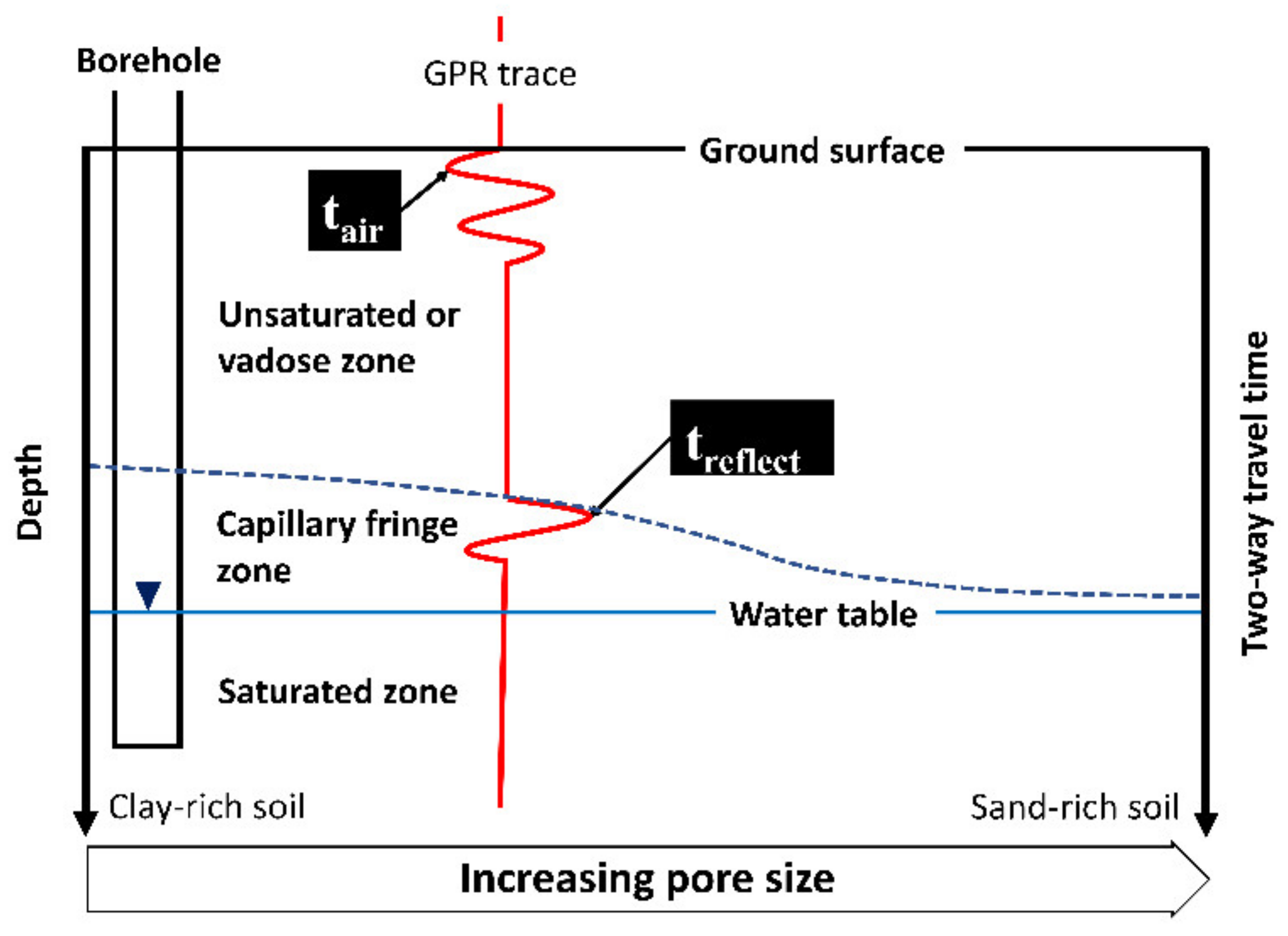
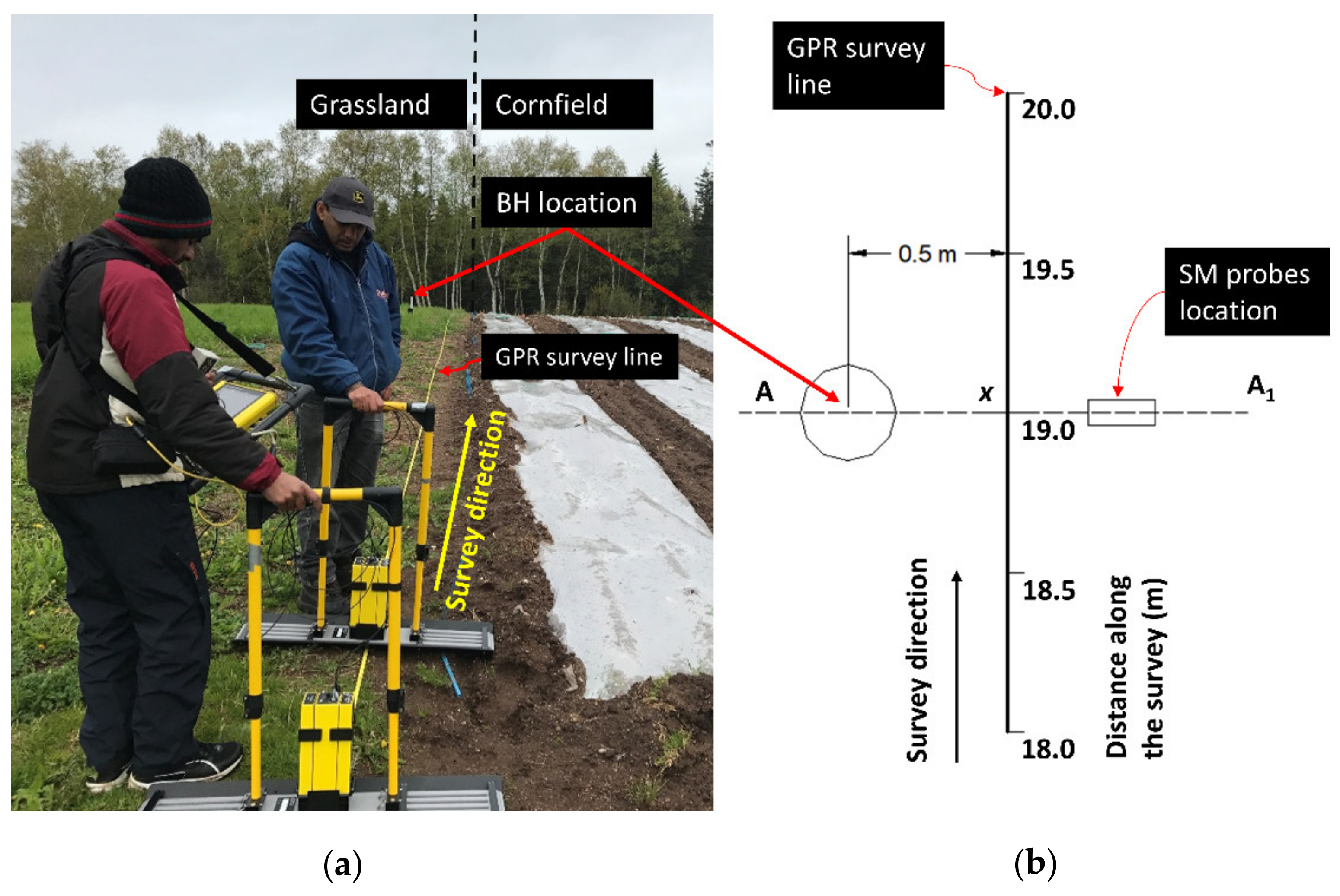
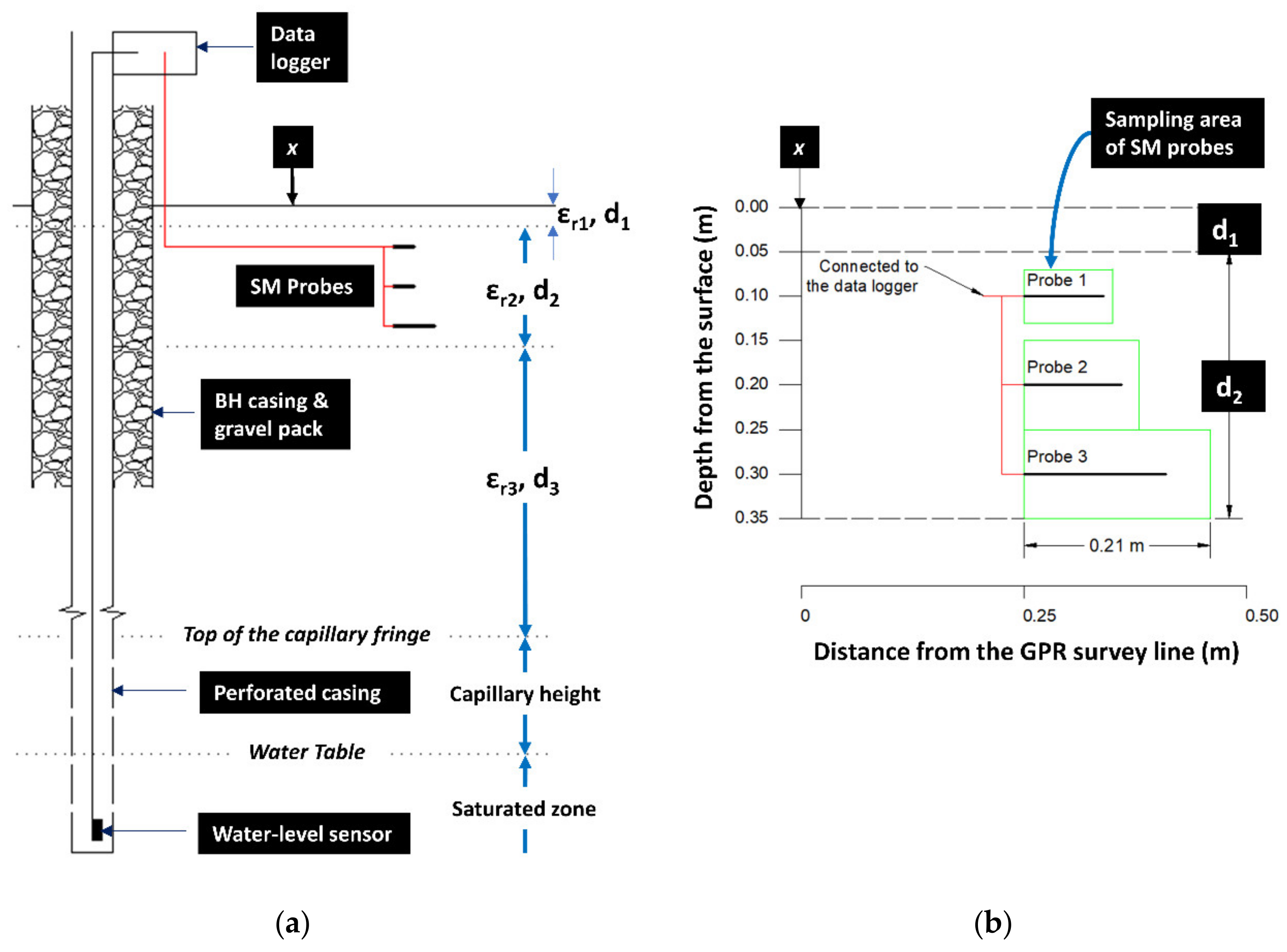

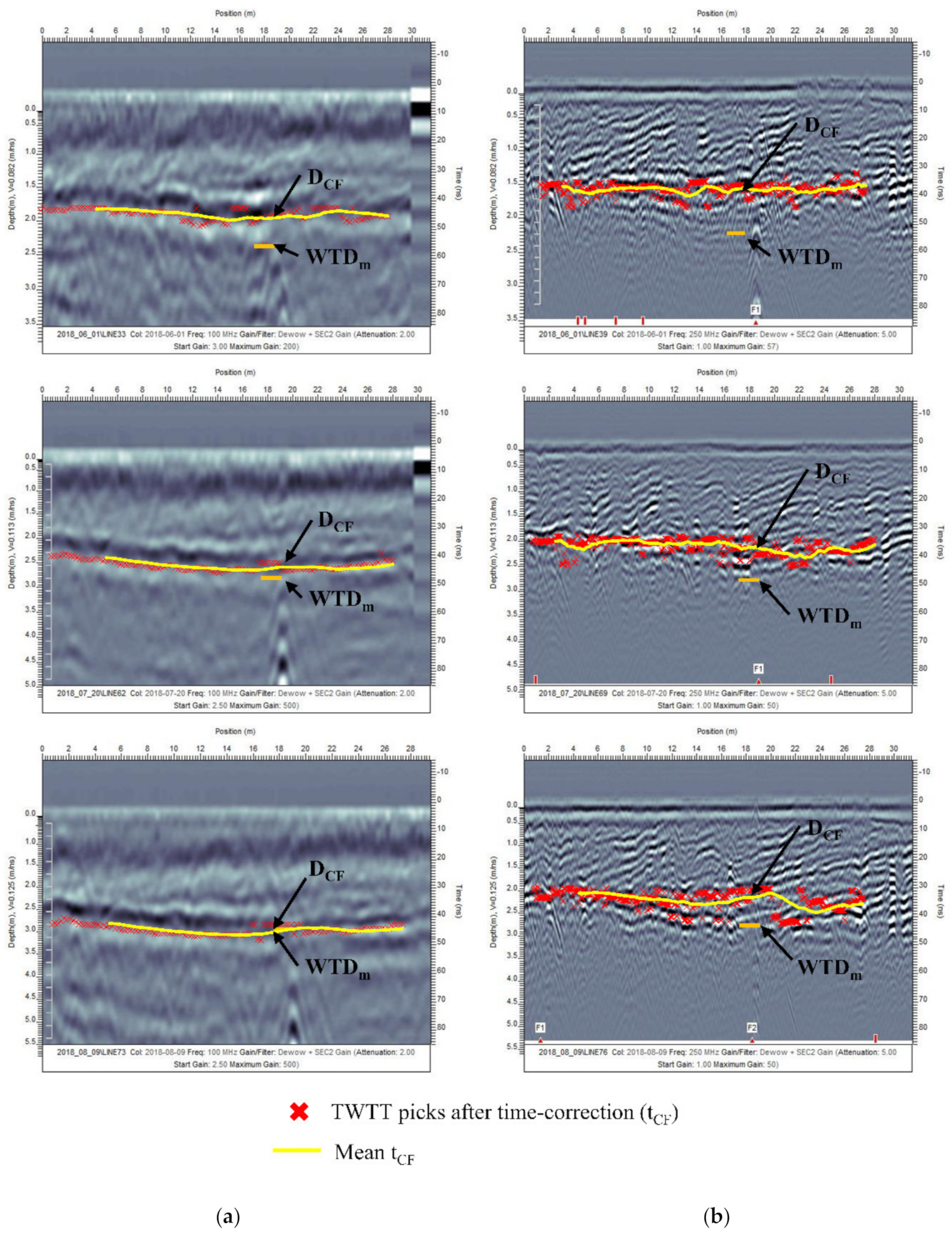
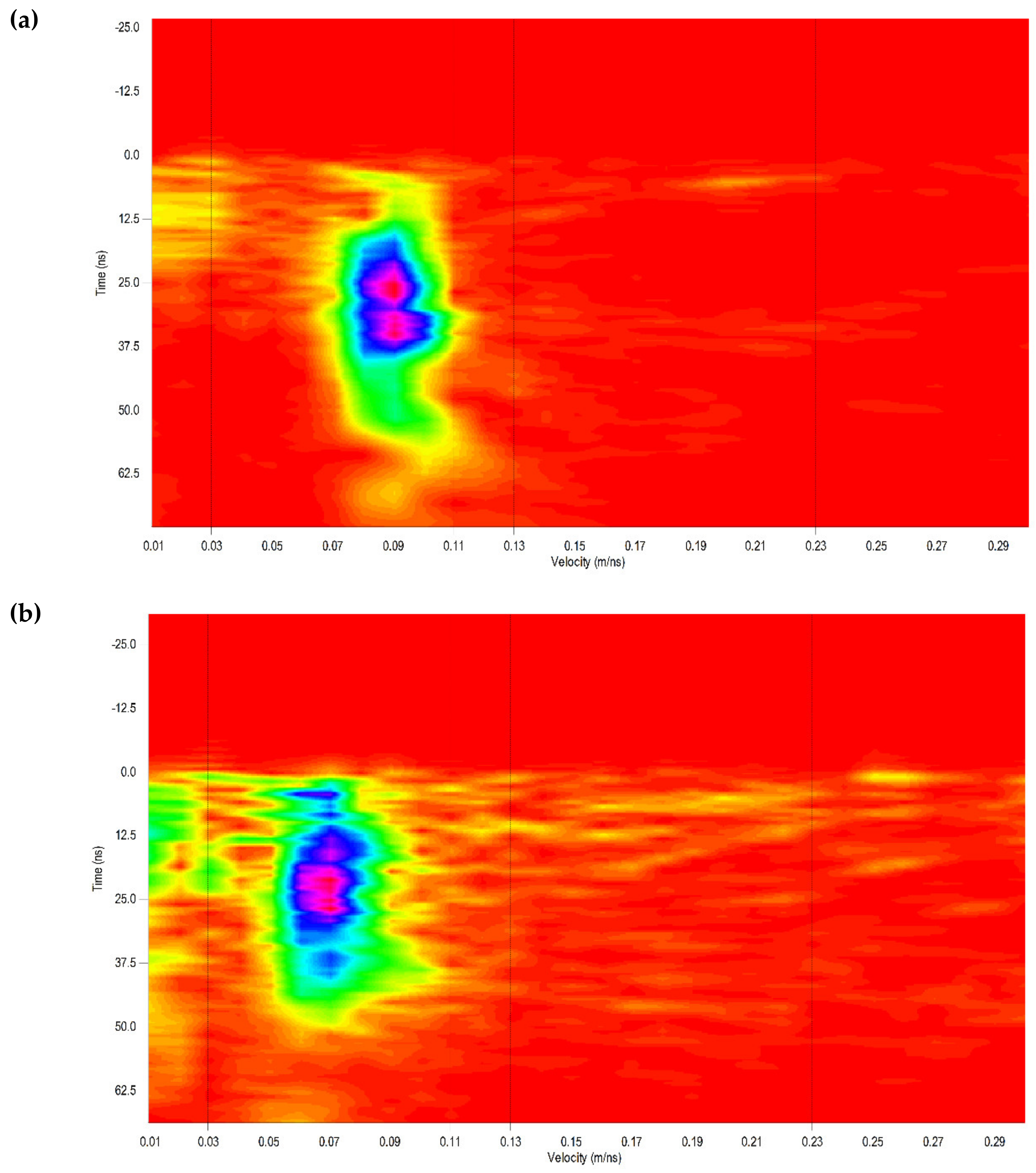
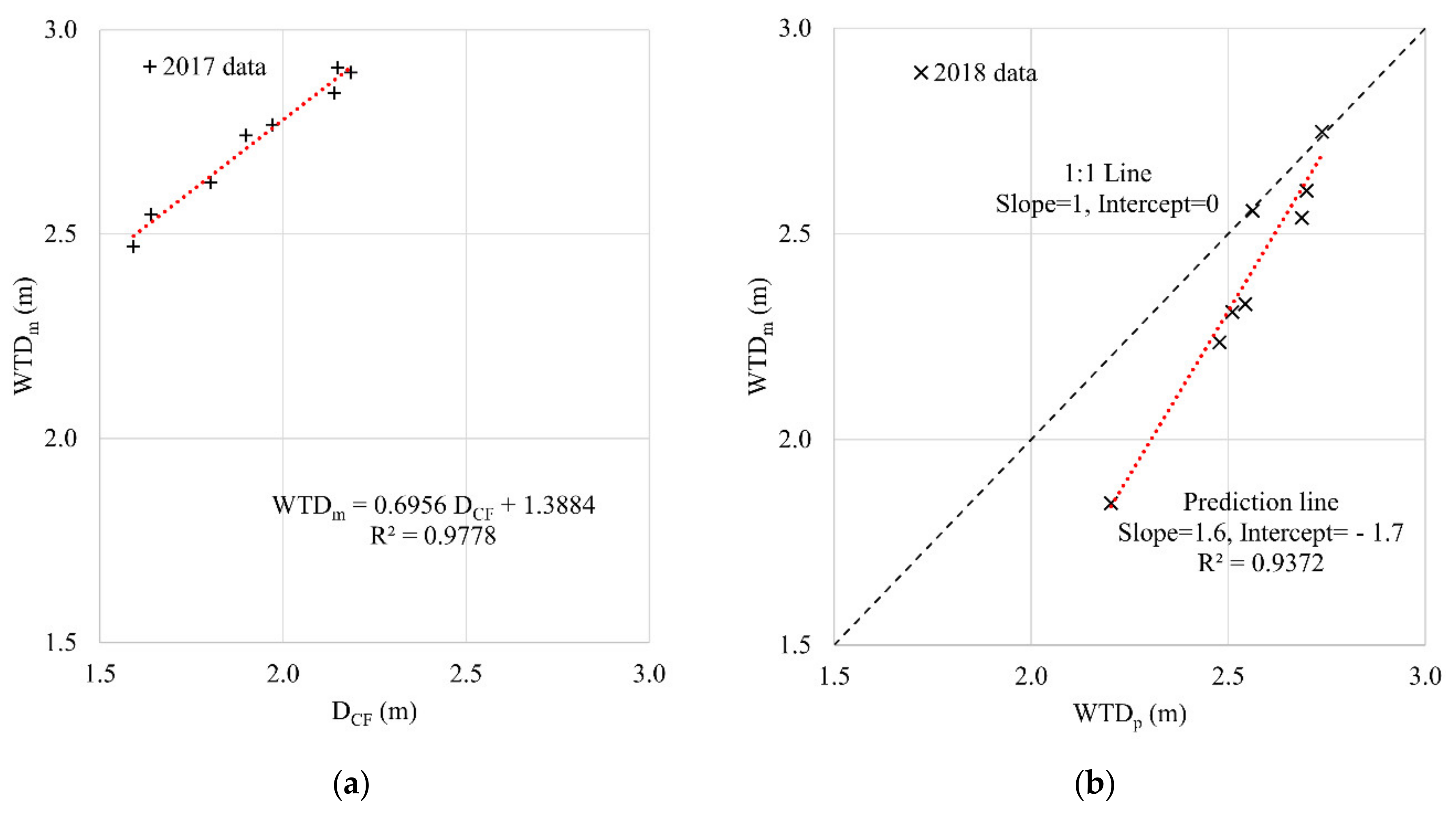

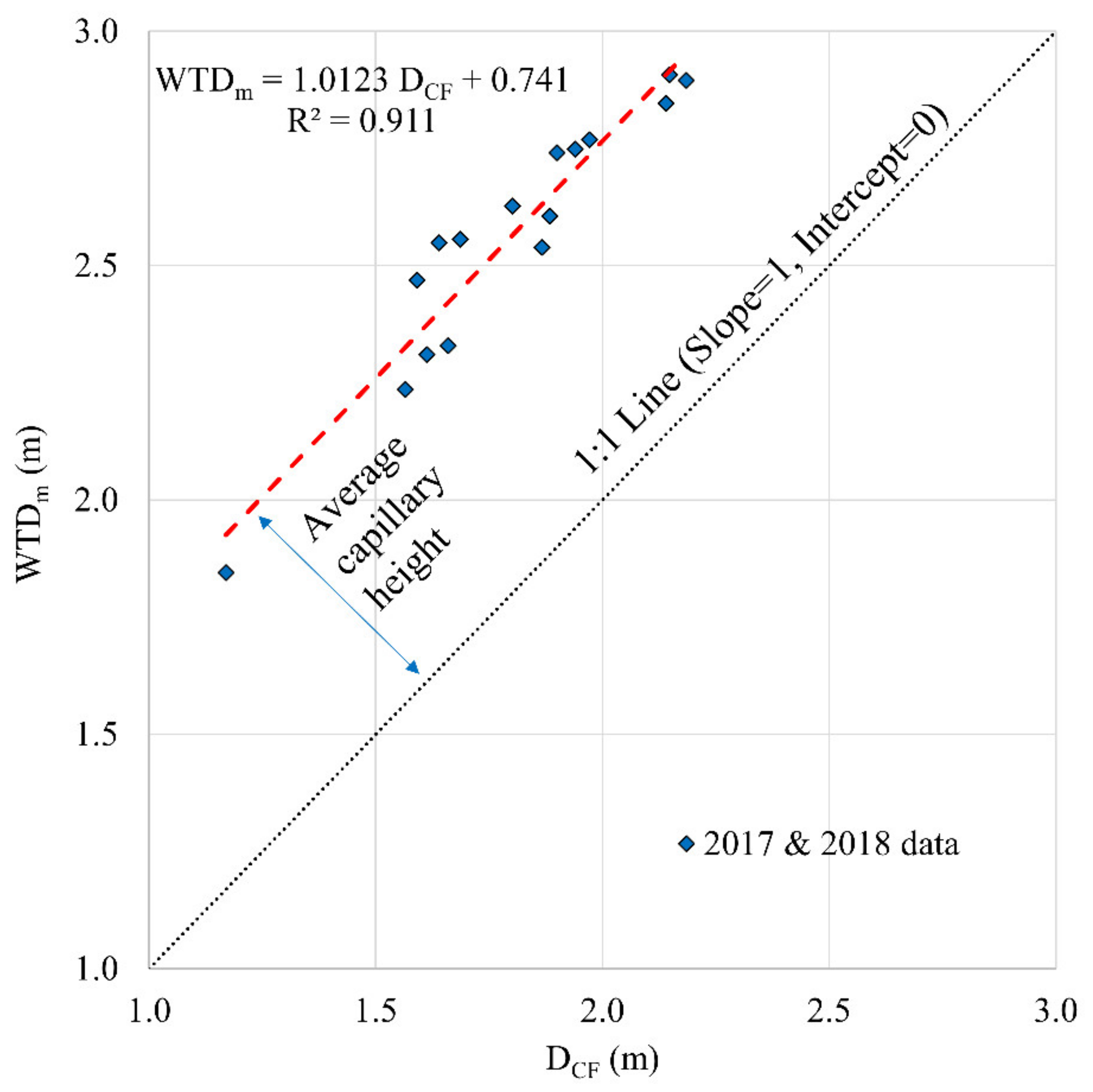
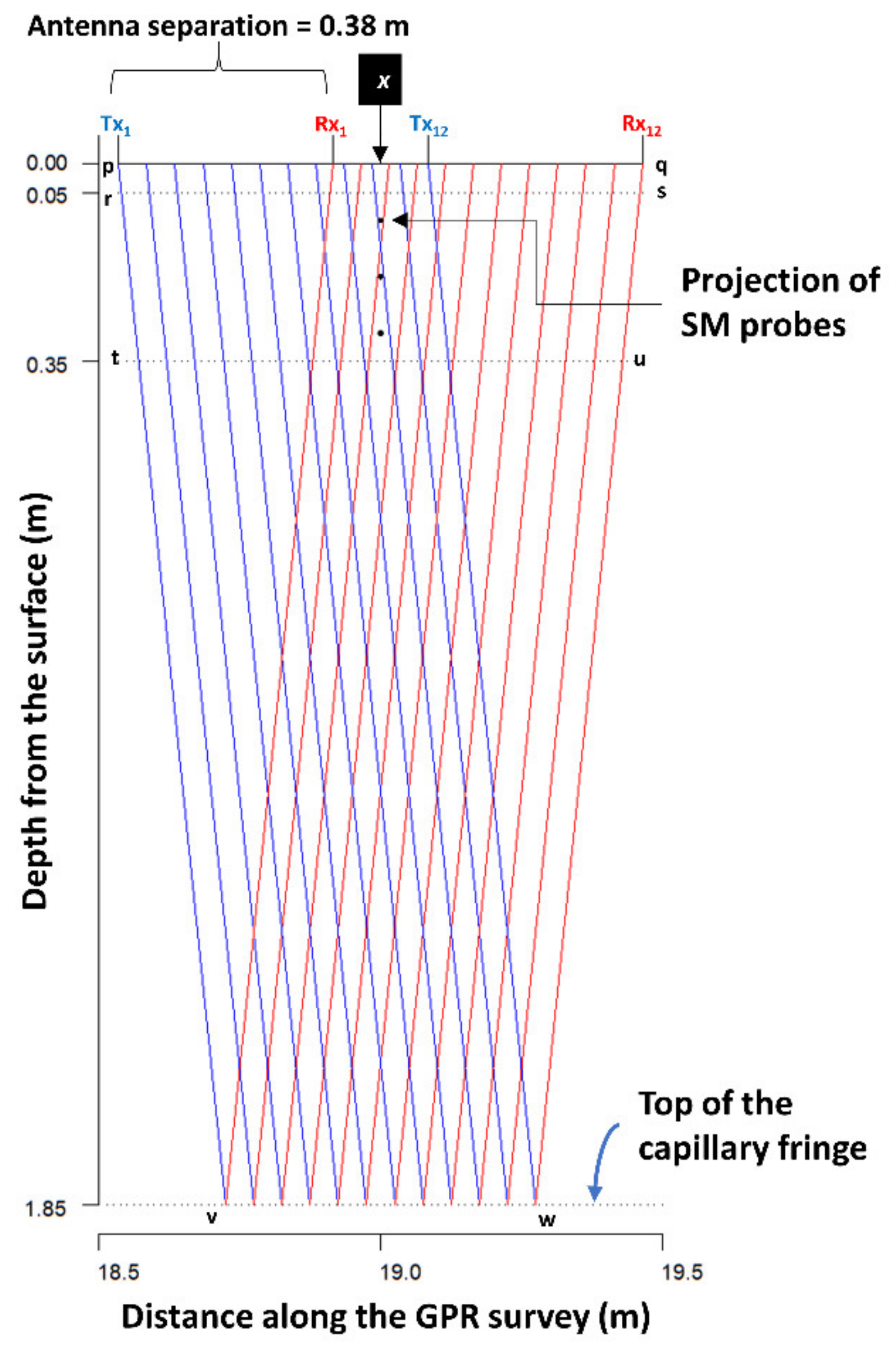
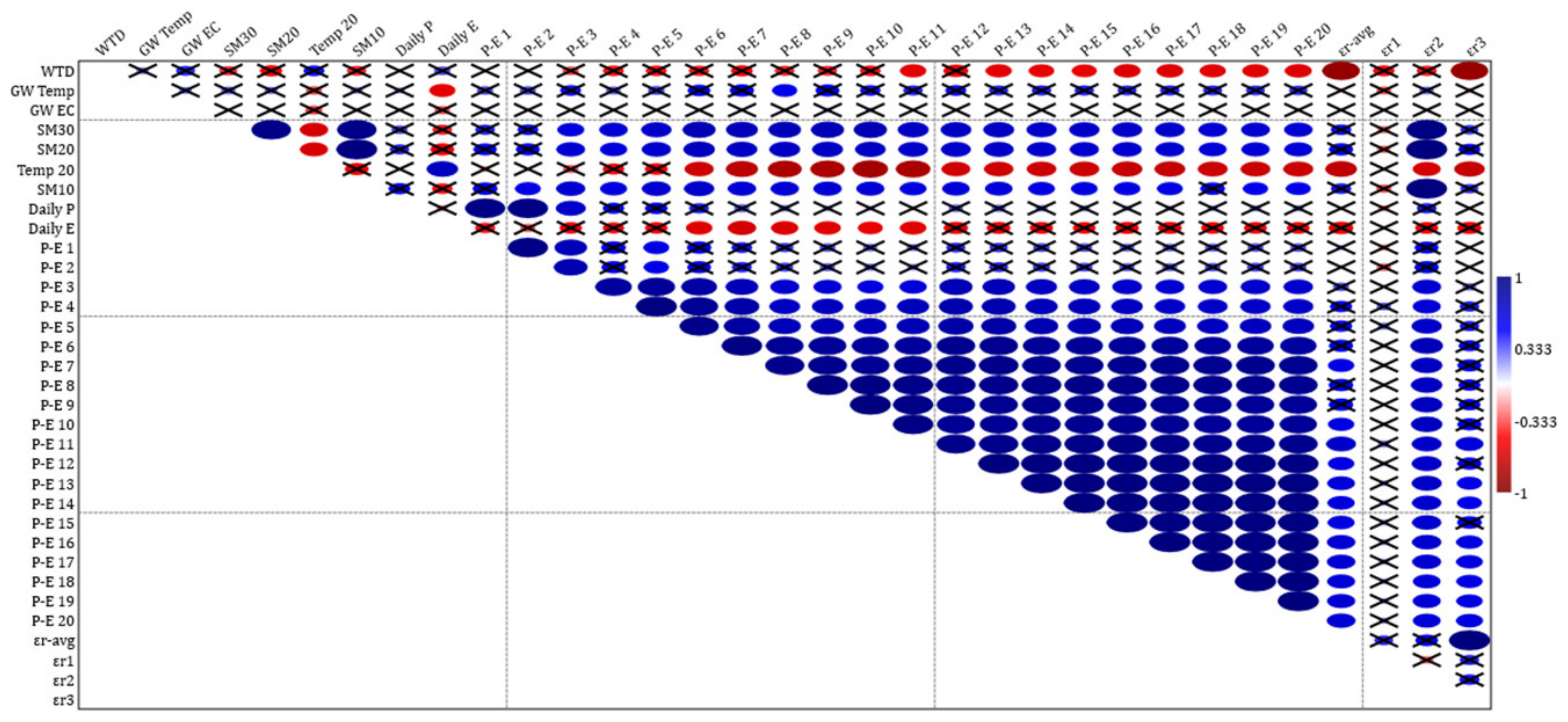
| Soil Layer | Depth Range (m) | Layer Thickness (m) | Relative Permittivity |
|---|---|---|---|
| Topsoil | 0–0.05 | d1 = 0.05 | εr1 |
| Loamy sand | 0.05–0.35 | d2 = 0.30 | εr2 |
| Sand (unsaturated) | 0.35—top of the capillary fringe | d3 = WTDm 1 − CF 2 − 0.35 | εr3 |
| Date | tCF (ns) | CMP Derived vrw (m/ns) | DCF (m) (= vrw × tCF/2) | ||||
|---|---|---|---|---|---|---|---|
| Min | Median | Max | Mean | SE | |||
| 23 June 2017 | 32.65 | 35.08 | 38.04 | 35.07 ± 1.70 | 0.43 | 0.091 | 1.60 |
| 6 July 2017 | 27.97 | 28.51 | 34.80 | 29.21 ± 1.93 | 0.58 | 0.112 | 1.64 |
| 28 July 2017 | 27.71 | 28.82 | 39.78 | 32.40 ± 5.39 | 1.44 | 0.117 | 1.90 |
| 18 August 2017 | 32.11 | 37.81 | 39.67 | 36.43 ± 2.87 | 0.70 | 0.117 | 2.13 |
| 29 August 2017 | 30.21 | 32.29 | 39.16 | 33.59 ± 2.90 | 0.70 | 0.130 | 2.18 |
| 15 September 2017 | 27.70 | 35.23 | 38.83 | 34.31 ± 3.86 | 1.11 | 0.125 | 2.14 |
| 3 October 2017 | 32.80 | 36.26 | 42.15 | 36.84 ± 3.69 | 1.02 | 0.107 | 1.97 |
| 7 November 2017 | 33.09 | 39.45 | 44.36 | 40.23 ± 4.53 | 1.26 | 0.090 | 1.81 |
| 1 June 2018 | 35.64 | 39.35 | 40.59 | 38.08 ± 2.06 | 0.47 | 0.082 | 1.56 |
| 20 June 2018 | 30.18 | 31.38 | 40.54 | 33.35 ± 3.82 | 0.83 | 0.100 | 1.67 |
| 29 June 2018 | 30.07 | 30.73 | 34.40 | 31.18 ± 1.35 | 0.33 | 0.103 | 1.61 |
| 20 July 2018 | 28.07 | 35.20 | 37.56 | 32.89 ± 3.33 | 0.77 | 0.113 | 1.86 |
| 9 August 2018 | 28.15 | 28.80 | 32.69 | 30.25 ± 2.01 | 0.44 | 0.125 | 1.89 |
| 7 September 2018 | 27.78 | 29.29 | 36.47 | 30.05 ± 2.67 | 0.67 | 0.129 | 1.94 |
| 2 October 2018 | 34.33 | 35.42 | 41.31 | 36.93 ± 2.65 | 0.61 | 0.091 | 1.68 |
| 31 October 2018 | 27.93 | 31.27 | 35.56 | 31.64 ± 2.78 | 0.61 | 0.074 | 1.17 |
| Soil Layer | Polygon (Refer to Figure 9) | Area (m2) | Percentage Out of Total GPR Sample Area (%) |
|---|---|---|---|
| Topsoil | pqsr | 0.0462 | 3.4 |
| Loamy sand | rsut | 0.2667 | 19.5 |
| Sand (unsaturated) | tuwv | 1.0561 | 77.1 |
| Total | pqwv | 1.3690 | 100.0 |
| Date | WTD (m) | d3 (= WTD − 0.7 − d1 − d2) (m) | εr−avg | εr1 | εr2 | εr3 |
|---|---|---|---|---|---|---|
| 23 June 2017 | 2.47 | 1.42 | 10.9 | 23.0 | 10.5 | 10.5 |
| 6 July 2017 | 2.55 | 1.50 | 7.1 | 4.0 | 12.2 | 6.0 |
| 28 July 2017 | 2.74 | 1.69 | 6.5 | 13.2 | 7.5 | 6.1 |
| 18 August 2017 | 2.85 | 1.80 | 6.5 | 10.9 | 7.8 | 6.0 |
| 29 August 2017 | 2.90 | 1.85 | 5.3 | 19.5 | 8.1 | 4.0 |
| 15 September 2017 | 2.91 | 1.86 | 5.7 | 14.0 | 11.2 | 4.2 |
| 3 October 2017 | 2.77 | 1.72 | 7.9 | 6.2 | 11.6 | 7.0 |
| 7 November 2017 | 2.63 | 1.58 | 11.2 | 13.1 | 13.7 | 10.5 |
| 1 June 2018 | 2.24 | 1.19 | 13.3 | 15.2 | 12.2 | 13.5 |
| 20 June 2018 | 2.33 | 1.28 | 9.1 | 14.0 | 12.5 | 8.0 |
| 29 June 2018 | 2.31 | 1.26 | 8.4 | 19.5 | 12.1 | 7.0 |
| 20 July 2018 | 2.54 | 1.49 | 7.0 | 20.0 | 8.6 | 6.3 |
| 9 August 2018 | 2.61 | 1.56 | 5.8 | 6.5 | 12.8 | 4.0 |
| 7 September 2018 | 2.75 | 1.70 | 5.4 | 4.0 | 12.8 | 4.1 |
| 2 October 2018 | 2.56 | 1.51 | 10.8 | 8.0 | 12.4 | 10.5 |
| 31 October 2018 | 1.86 | 0.81 | 16.5 | 23.3 | 13.1 | 17.0 |
© 2020 by the authors. Licensee MDPI, Basel, Switzerland. This article is an open access article distributed under the terms and conditions of the Creative Commons Attribution (CC BY) license (http://creativecommons.org/licenses/by/4.0/).
Share and Cite
Illawathure, C.; Cheema, M.; Kavanagh, V.; Galagedara, L. Distinguishing Capillary Fringe Reflection in a GPR Profile for Precise Water Table Depth Estimation in a Boreal Podzolic Soil Field. Water 2020, 12, 1670. https://doi.org/10.3390/w12061670
Illawathure C, Cheema M, Kavanagh V, Galagedara L. Distinguishing Capillary Fringe Reflection in a GPR Profile for Precise Water Table Depth Estimation in a Boreal Podzolic Soil Field. Water. 2020; 12(6):1670. https://doi.org/10.3390/w12061670
Chicago/Turabian StyleIllawathure, Chameera, Mumtaz Cheema, Vanessa Kavanagh, and Lakshman Galagedara. 2020. "Distinguishing Capillary Fringe Reflection in a GPR Profile for Precise Water Table Depth Estimation in a Boreal Podzolic Soil Field" Water 12, no. 6: 1670. https://doi.org/10.3390/w12061670
APA StyleIllawathure, C., Cheema, M., Kavanagh, V., & Galagedara, L. (2020). Distinguishing Capillary Fringe Reflection in a GPR Profile for Precise Water Table Depth Estimation in a Boreal Podzolic Soil Field. Water, 12(6), 1670. https://doi.org/10.3390/w12061670






